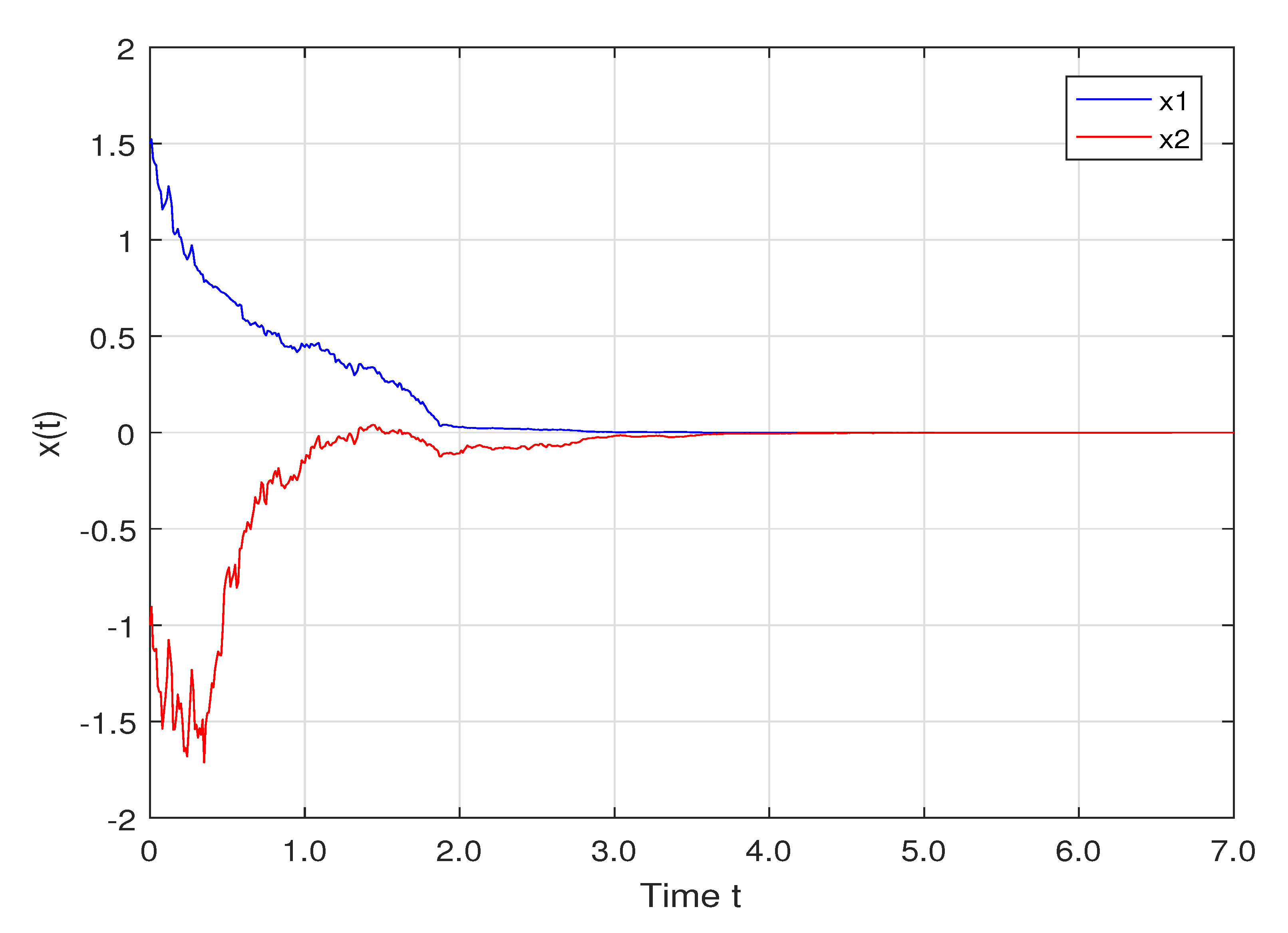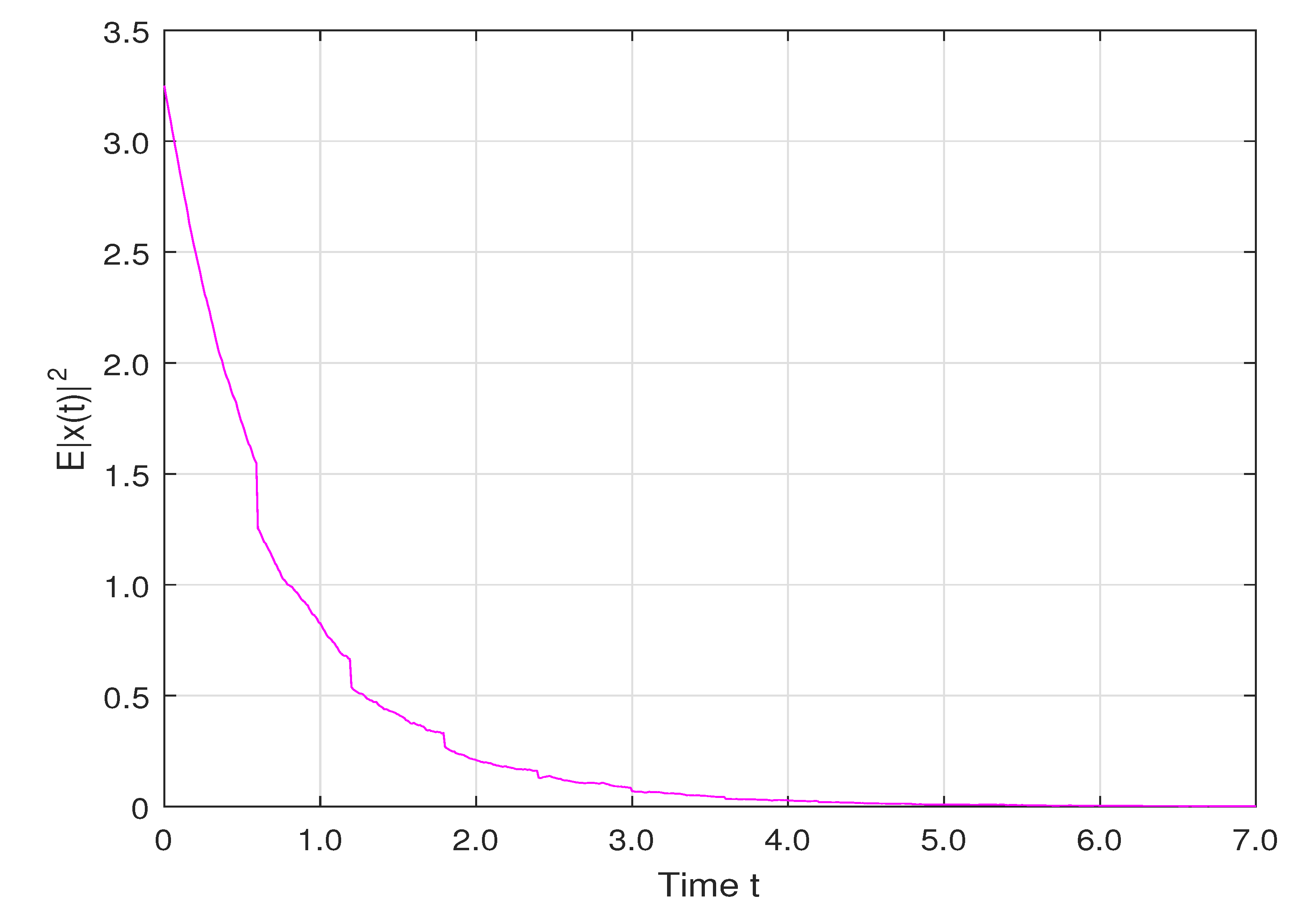Delay-Dependent Stability of Impulsive Stochastic Systems with Multiple Delays
Abstract
:1. Introduction
- (i)
- A DDS theorem for exponential stability of ISDSs is founded by using an appropriate LKF, which can be verified by the feasibility of LMIs.
- (ii)
- When mean-square stability is considered, we propose sufficient conditions for this kind of ISDSs, and the established DDS criterion does not rely on the existence of delays in the diffusion term.
2. Preliminaries
- (i)
- The set of impulses is finite;
- (ii)
- For , is right-continuous, i.e., . is continuous for all non-impulsive times (i.e., ) and adapted;
- (iii)
- For any , , the following equation:holds with probability 1.
- (i)
- For every moment , and exist in . Moreover, ;
- (ii)
- For , is continuously twice differentiable in and once in t.
3. Main Results
4. Examples
5. Conclusions
Author Contributions
Funding
Institutional Review Board Statement
Informed Consent Statement
Data Availability Statement
Conflicts of Interest
References
- Gu, K.; Kharitonov, V.L.; Chen, J. Stability of Time-Delay Systems; Birkhäuser: Boston, MA, USA, 2003. [Google Scholar]
- Wang, H.; Zhang, H.; Xie, L. Optimal control and stabilization for It systems with input delay. J. Syst. Sci. Complex. 2021, 34, 1895–1926. [Google Scholar] [CrossRef]
- Yan, S.; Shen, M.; Nguang, S.K.; Zhang, G. Event-triggered H∞ control of networked control systems with distributed transmission delay. IEEE Trans. Autom. Control 2020, 65, 4295–4301. [Google Scholar] [CrossRef]
- Lin, H.; Zeng, H.; Wang, W. New Lyapunov-Krasovskii functional for stability analysis of linear systems with time-varying delay. J. Syst. Sci. Complex. 2021, 34, 632–641. [Google Scholar] [CrossRef]
- Shi, J.; Wang, G. A non-zero differential game of BSDE with time-delayed generator with applications. IEEE Trans. Autom. Control 2016, 61, 1959–1964. [Google Scholar] [CrossRef]
- Ni, Y.; Yiu, C.; Zhang, H.; Zhang, J. Delayed optimal control of stochastic LQ problem. SIAM J. Control Optim. 2017, 55, 3370–3407. [Google Scholar] [CrossRef] [Green Version]
- Emilia, F. Introduction to Time-Delay Systems: Analysis and Control; Birkhäuser: Basel, Switzerland, 2014. [Google Scholar]
- Yan, H.; Tian, Y.; Li, H.; Zhang, H.; Li, Z. Input-output finite-time mean square stabilisation of nonlinear semi-Markovian jump systems with time-varying delay. Automatica 2019, 104, 82–89. [Google Scholar] [CrossRef]
- Feng, W.; Xie, Y.; Luo, F.; Zhang, X.; Duan, W. Enhanced stability criteria of network-based load frequency control of power systems with time-varying delays. Energies 2021, 14, 5820. [Google Scholar] [CrossRef]
- Chen, W.; Wang, Z.; Lu, X. Delay-dependent exponential stability of uncertain stochastic systems with multiple delays: An LMI approach. Syst. Control Lett. 2005, 54, 547–555. [Google Scholar] [CrossRef]
- Yue, D.; Han, Q. Delay-dependent exponential stability of stochastic systems with time-varying delays, nonlinearities and Markovian jump parameters. IEEE Trans. Autom. Control 2005, 50, 217–222. [Google Scholar]
- Luo, S.; Deng, F. A note on delay-dependent stability of It-type stochastic time-delay systems. Automatica 2019, 105, 443–447. [Google Scholar] [CrossRef]
- Tunç, O.; Tunç, C.; Wang, Y. Delay-dependent stability, integrability and boundedeness criteria for delay differential systems. Axioms 2021, 10, 138. [Google Scholar] [CrossRef]
- Lakshmikantham, V. Theory of Impulsive Differential Equations; World Scientific: Singapore, 1989. [Google Scholar]
- Samoilenko, A.M.; Perestyuk, N.A. Impulsive Differential Equations; World Scientific: Singapore, 1995. [Google Scholar]
- Chen, W.; Zheng, W. Exponential stability of nonlinear time-delay systems with delayed impulse effects. Automatica 2011, 47, 1075–1083. [Google Scholar] [CrossRef]
- Peng, S.; Deng, F.; Zhang, Y. A unified Razumikhin-type criterion on input-to-state stability of time-varying impulsive delayed systems. Syst. Control Lett. 2018, 45, 20–28. [Google Scholar] [CrossRef]
- Ren, W.; Xiong, J. Stability analysis of impulsive switched time-delay systems with state-dependent impulses. IEEE Trans. Autom. Control 2019, 64, 3928–3935. [Google Scholar] [CrossRef]
- Xu, S.; Chen, T. Robust H∞ filtering for uncertain impulsive stochastic systems under sampled measurements. Automatica 2003, 39, 509–516. [Google Scholar] [CrossRef]
- Mohamad, S.A.; Liu, X.; Xie, W. Existence, continuation, and uniqueness problems of stochastic impulsive systems with time delay. J. Frankl. Inst. 2010, 347, 1317–1333. [Google Scholar]
- Cheng, P.; Deng, F. Global exponential stability of impulsive stochastic functional differential systems. Stat. Probab. Lett. 2010, 80, 1854–1862. [Google Scholar] [CrossRef]
- Zhu, Q. pth moment exponential stability of impulsive stochastic functional differential equations with Markovian switching. J. Frankl. Inst. 2014, 351, 3965–3986. [Google Scholar] [CrossRef]
- Pan, L.; Cao, J.; Ren, Y. Impulsive stability of stochastic functional differential systems driven by G-Brownian motion. Mathematics 2020, 8, 227. [Google Scholar] [CrossRef] [Green Version]
- Ngoc, P.; Hieu, L. A novel approach to mean square exponential stability of stochastic delay differential equations. IEEE Trans. Autom. Control. 2020, 66, 2351–2356. [Google Scholar] [CrossRef]
- Yang, J.; Zhong, S.; Luo, P. Mean square stability analysis of impulsive stochastic differential equations with delays. J. Comput. Appl. Math. 2008, 216, 474–483. [Google Scholar] [CrossRef] [Green Version]
- Zhu, Q.; Song, B. Exponential stability of impulsive nonlinear stochastic differential equations with mixed delays. Nonlinear Anal. Real World Appl. 2011, 12, 2851–2860. [Google Scholar] [CrossRef]
- Rami, M.A.; Zhou, X. Linear matrix inequalities, Riccati equations, and indefinite stochastic linear quadratic controls. IEEE Trans. Autom. Control 2000, 45, 1131–1143. [Google Scholar] [CrossRef]
- Mao, X. Stochastic Differential Equations and Applications, 2nd ed.; Howrwood Publishing: Chichester, UK, 2007. [Google Scholar]
- Emilia, F. New Lyapunov-Krasovskii functionals for stability of linear retarded and neutral type systems. Syst. Control Lett. 2001, 43, 309–319. [Google Scholar]
- Yang, G.; Yao, J.; Dong, Z. Neuroadaptive learning algorithm for constrained nonlinear systems with disturbance rejection. Int. J. Robust Nonlinear Control 2022, 32, 6127–6147. [Google Scholar] [CrossRef]
- Yang, G.; Yao, J.; Ullah, N. Neuroadaptive control of saturated nonlinear systems with disturbance compensation. ISA Trans. 2022, 122, 49–62. [Google Scholar] [CrossRef]



Publisher’s Note: MDPI stays neutral with regard to jurisdictional claims in published maps and institutional affiliations. |
© 2022 by the authors. Licensee MDPI, Basel, Switzerland. This article is an open access article distributed under the terms and conditions of the Creative Commons Attribution (CC BY) license (https://creativecommons.org/licenses/by/4.0/).
Share and Cite
Xiao, C.; Hou, T. Delay-Dependent Stability of Impulsive Stochastic Systems with Multiple Delays. Processes 2022, 10, 1258. https://doi.org/10.3390/pr10071258
Xiao C, Hou T. Delay-Dependent Stability of Impulsive Stochastic Systems with Multiple Delays. Processes. 2022; 10(7):1258. https://doi.org/10.3390/pr10071258
Chicago/Turabian StyleXiao, Chunjie, and Ting Hou. 2022. "Delay-Dependent Stability of Impulsive Stochastic Systems with Multiple Delays" Processes 10, no. 7: 1258. https://doi.org/10.3390/pr10071258
APA StyleXiao, C., & Hou, T. (2022). Delay-Dependent Stability of Impulsive Stochastic Systems with Multiple Delays. Processes, 10(7), 1258. https://doi.org/10.3390/pr10071258




